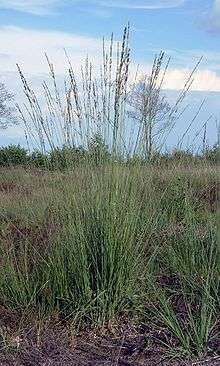Molinia caerulea
| Purple moor-grass | |
|---|---|
 | |
| Habitus | |
| Scientific classification | |
| Kingdom: | Plantae |
| (unranked): | Angiosperms |
| (unranked): | Monocots |
| (unranked): | Commelinids |
| Order: | Poales |
| Family: | Poaceae |
| Genus: | Molinia |
| Species: | M. caerulea |
| Binomial name | |
| Molinia caerulea (L.) Moench | |
| Synonyms | |
|
Aira caerulea | |
Molinia caerulea (purple moor-grass[1]) is a species of flowering plant in the grass family Poaceae, native to Europe, west Asia, and north Africa. It grows in locations from the lowlands up to 2,300 m (7,546 ft) in the Alps. Like most grasses, it grows best in acid soils, ideally pH values of between 3.5 and 5, however, it can continue to live under more extreme conditions, sometimes to as low as 2. It is common on moist heathland, bogs and moorland throughout Britain. Introduced populations exist in northeastern and northwestern North America.[2]
The specific epithet caerulea means "deep blue"[3] and refers to the purple spikelets.
Identification
Molinia caerulea is an herbaceous perennial bunchgrass (tussock-forming), growing up to 90 cm (35 in) tall (taller when sheltered by gorse and heather), with many closely packed stems. The leaves are coarse, green, taper to a point, long, flat and sometimes slightly hairy on top.[4] Due to the dense tussock it is very resistant to heath fires. Its ligule is a ring of hairs, as in heath grass (Danthonia decumbens). The long narrow purple spikelets are a major identification feature - the panicle is 15 cm (6 in) long.
It flowers between July and September, later than any other species.
Ecology
The caterpillars of some Lepidoptera use it as a foodplant, e.g., the chequered skipper (Carterocephalus palaemon).
Claviceps purpurea is an ascomycetous fungus which grows on the seeds of purple moor grass.
Purple moor grass and rush pastures is a United Kingdom Biodiversity Action Plan, on account of its rarity.[5]
Cultivation
M. caerulea is cultivated for its panicles of purple spikelets on yellow stems. In cultivation it grows to 1.5 m (5 ft) tall by 40 cm (16 in) broad.[6] Numerous cultivars have been selected, of which M. caerulea subsp. caerulea 'Variegata' has gained the Royal Horticultural Society's Award of Garden Merit.[7]
References
- ↑ "BSBI List 2007". Botanical Society of Britain and Ireland. Archived from the original (xls) on 2015-02-25. Retrieved 2014-10-17.
- ↑ Molinia caerulea (L.) Moench
- ↑ Harrison, Lorraine (2012). RHS Latin for gardeners. United Kingdom: Mitchell Beazley. p. 224. ISBN 9781845337315.
- ↑ Grasses by C E Hubbard, 1978, published by Penguin books
- ↑ UK BAP Purple Moor and Rush Pastures
- ↑ RHS A-Z encyclopedia of garden plants. United Kingdom: Dorling Kindersley. 2008. p. 1136. ISBN 1405332964.
- ↑ "RHS Plant Selector - Molinia caerulea subsp. caerulea 'Variegata'". Retrieved 24 May 2013.
- Food and agriculture organization of the United Nations page on purple moor grass.
- Collins Pocket Guide Grasses Sedges Rushes and Ferns of Britain and Northern Europe, R Fitter, A Fitter, A Farrer
- Rose, Frances, 1974. Grasses, sedges and rushes, page 18-19
- "The Highwayman" Alfred Noyes
Gallery







 Habitus (German Horst)
Habitus (German Horst) Leaf and vegetative parts
Leaf and vegetative parts- Molinia caerulea at natural habitat near Silkeborg, Denmark.
 Sclerotium of Claviceps purpurea which grows on the seeds of purple moor grass.
Sclerotium of Claviceps purpurea which grows on the seeds of purple moor grass.
External links
| Wikimedia Commons has media related to Molinia caerulea. |